Highlands Hospital
World's End Lane, Winchmore Hill, N21 1PN
Medical dates:
Medical character:
Infectious disease. Later, general, acute
In 1884 the Metropolitan Asylums
Board (MAB) purchased a 36-acre site from the Chaseville Park estate
(originally part of Enfield Chase) in order to build an infectious
diseases hospital for convalescent patients in north London (the
equivalent one planned for south London would be at Gore Farm near
Dartford, later known as the Southern Convalescent Fever Hospital).
Work began on the site, with the foundation stone being laid in
May 1885.
The Northern Convalescent Fever Hospital opened in September 1887 with 739 beds. Its situation was quite rural, the nearest town being Enfield with about 30,000 inhabitants.
Rather than being located in one large building, the wards were distributed in 2-storey L-shaped villas (pavilions), arranged around an oval and spaced at about 40 metre intervals. The 18 pavilions were numbered, but there was no Pavilion 13 due to superstition (it was known as 12a). Built of yellow brick with red brick dressings in the Queen Anne revival style, they resembled large domestic houses. Each contained on the ground floor a dining room, a sitting room, a verandah and WCs (the kitchen was in a single-storey annexe), while on the upper floor were 32 beds and a Charge Nurse's room, together with bathrooms and WCs. This self-contained accommodation ensured minimal contact between patients suffering from contagious diseases, such as typhoid, scarlet fever and diphtheria.
The 2-storey administration block at the east of the site contained staff offices and a Board Room, as well as kitchens, a laundry and a coal store. Accommodation for nurses and domestic staff was provided on its upper floor. Other buildings contained smaller wards and staff quarters. A separate mortuary was located behind the administration building.
By 1890 demand for beds was so high that nine temporary ward huts made of iron and wood - each 113 ft long (34 metres) were erected in seven weeks, providing an extra 200 beds. In the following year more temporary huts were built on an adjacent site to the northeast of the Hospital (these were later replaced in 1900 by the Enfield Isolation Hospital).
In 1893 the word 'Fever' was dropped from the Hospital's title and is became the Northern Convalescent Hospital. In 1900 the word 'Convalescent' was also dropped, and it became known simply as the Northern Hospital.
By 1924 it had 671 beds, 125 of which were used for patients with advanced TB. They were treated with heliotherapy (sunlight treatment). The remainder were used for convalescent children from MAB's other infectious diseases hospitals. In November 1925 MAB established a special unit with 100 beds for children between the ages of 3 and 16 years who had survived encephalitis lethargica (see below), but needed long term care. The unit was housed in four pavilions of 25 beds each.
In 1930 control of the Hospital passed to the LCC.
During the mid 1930s the open land surrounding the Hospital was developed for housing, and its rural isolation was lost.
During WW2 it became an Emergency Bed Service hospital for patients from all over London.
When it joined the NHS in 1948 it was renamed the Highlands General Hospital (to avoid confusion with the Royal Northern Hospital) and became a general hospital. It had 818 beds.
In 1952 the buildings were modernised, with several pavilions being converted into two 26-bedded wards. One pavilion became the Out-Patients Department. A modern X-ray unit and a modern kitchen were provided. An operating theatre unit with two theatres was installed. One of the smaller pavilions became the Nurses Training School when, in 1956, the General Nursing Council recognised the Hospital as a training school for general nursing. In 1960 it had 734 mainly acute beds.
In April 1963 administrative control of the Hospital transferred to the Barnet Group Hospital Management Committee (HMC), as part of the North West Metropolitan Regional Health Board (RHB). In 1964 the Hospital had 704 beds, of which 504 were staffed and available. The Barnet Group HMC intended to improve staffing quotas but, before this could happen, it was informed in February 1965 that the Hospital would be transferred on 1st April to the North East Metropolitan RHB, under the control of the Enfield Group HMC. The Barnet Group managers strongly protested against this fait accompli, but to no avail. Boundary changes brought about by the Local Government Act, 1963, placed the Borough of Southgate in the North East Metropolitan region. Shortly after the transfer, the Enfield Group HMC merged with the Edmonton Group HMC, ensuring that Highlands Hospital had been governed by four different HMCs in just over three years.
By 1965 it 654 beds. In 1966 it merged with the neighbouring South Lodge Hospital (the former Enfield Isolation Hospital), which became part of the Highlands Hospital. It became an acute hospital with an Accident and Emergency Department.
In 1974, following a reorganisation of the NHS, it became the Highlands Wing of the Enfield District Hospital (the other part of which was Chase Farm Hospital). It had 550 beds for acute and maternity cases.
By 1982 it had 456 beds for mainly acute patients but, in 1984, the Accident and Emergency Department was closed temporarily (it never reopened). In 1986, when it had 427 beds, the Enfield District Health Authority decided to close the Hospital (in the same year the site was designated a conservation area, thus most of the original buildings have survived).
Medical services were gradually run down during the early 1990s, with some parts of the Hospital functioning while empty pavilions, mainly at the back of the site, were boarded up. The remaining services were relocated to Chase Farm Hospital and the 53-acre site was sold to developers in 1993.
The Hospital closed in 1998 with 374 beds.
The Northern Convalescent Fever Hospital opened in September 1887 with 739 beds. Its situation was quite rural, the nearest town being Enfield with about 30,000 inhabitants.
Rather than being located in one large building, the wards were distributed in 2-storey L-shaped villas (pavilions), arranged around an oval and spaced at about 40 metre intervals. The 18 pavilions were numbered, but there was no Pavilion 13 due to superstition (it was known as 12a). Built of yellow brick with red brick dressings in the Queen Anne revival style, they resembled large domestic houses. Each contained on the ground floor a dining room, a sitting room, a verandah and WCs (the kitchen was in a single-storey annexe), while on the upper floor were 32 beds and a Charge Nurse's room, together with bathrooms and WCs. This self-contained accommodation ensured minimal contact between patients suffering from contagious diseases, such as typhoid, scarlet fever and diphtheria.
The 2-storey administration block at the east of the site contained staff offices and a Board Room, as well as kitchens, a laundry and a coal store. Accommodation for nurses and domestic staff was provided on its upper floor. Other buildings contained smaller wards and staff quarters. A separate mortuary was located behind the administration building.
By 1890 demand for beds was so high that nine temporary ward huts made of iron and wood - each 113 ft long (34 metres) were erected in seven weeks, providing an extra 200 beds. In the following year more temporary huts were built on an adjacent site to the northeast of the Hospital (these were later replaced in 1900 by the Enfield Isolation Hospital).
In 1893 the word 'Fever' was dropped from the Hospital's title and is became the Northern Convalescent Hospital. In 1900 the word 'Convalescent' was also dropped, and it became known simply as the Northern Hospital.
By 1924 it had 671 beds, 125 of which were used for patients with advanced TB. They were treated with heliotherapy (sunlight treatment). The remainder were used for convalescent children from MAB's other infectious diseases hospitals. In November 1925 MAB established a special unit with 100 beds for children between the ages of 3 and 16 years who had survived encephalitis lethargica (see below), but needed long term care. The unit was housed in four pavilions of 25 beds each.
In 1930 control of the Hospital passed to the LCC.
During the mid 1930s the open land surrounding the Hospital was developed for housing, and its rural isolation was lost.
During WW2 it became an Emergency Bed Service hospital for patients from all over London.
When it joined the NHS in 1948 it was renamed the Highlands General Hospital (to avoid confusion with the Royal Northern Hospital) and became a general hospital. It had 818 beds.
In 1952 the buildings were modernised, with several pavilions being converted into two 26-bedded wards. One pavilion became the Out-Patients Department. A modern X-ray unit and a modern kitchen were provided. An operating theatre unit with two theatres was installed. One of the smaller pavilions became the Nurses Training School when, in 1956, the General Nursing Council recognised the Hospital as a training school for general nursing. In 1960 it had 734 mainly acute beds.
In April 1963 administrative control of the Hospital transferred to the Barnet Group Hospital Management Committee (HMC), as part of the North West Metropolitan Regional Health Board (RHB). In 1964 the Hospital had 704 beds, of which 504 were staffed and available. The Barnet Group HMC intended to improve staffing quotas but, before this could happen, it was informed in February 1965 that the Hospital would be transferred on 1st April to the North East Metropolitan RHB, under the control of the Enfield Group HMC. The Barnet Group managers strongly protested against this fait accompli, but to no avail. Boundary changes brought about by the Local Government Act, 1963, placed the Borough of Southgate in the North East Metropolitan region. Shortly after the transfer, the Enfield Group HMC merged with the Edmonton Group HMC, ensuring that Highlands Hospital had been governed by four different HMCs in just over three years.
By 1965 it 654 beds. In 1966 it merged with the neighbouring South Lodge Hospital (the former Enfield Isolation Hospital), which became part of the Highlands Hospital. It became an acute hospital with an Accident and Emergency Department.
In 1974, following a reorganisation of the NHS, it became the Highlands Wing of the Enfield District Hospital (the other part of which was Chase Farm Hospital). It had 550 beds for acute and maternity cases.
By 1982 it had 456 beds for mainly acute patients but, in 1984, the Accident and Emergency Department was closed temporarily (it never reopened). In 1986, when it had 427 beds, the Enfield District Health Authority decided to close the Hospital (in the same year the site was designated a conservation area, thus most of the original buildings have survived).
Medical services were gradually run down during the early 1990s, with some parts of the Hospital functioning while empty pavilions, mainly at the back of the site, were boarded up. The remaining services were relocated to Chase Farm Hospital and the 53-acre site was sold to developers in 1993.
The Hospital closed in 1998 with 374 beds.
Present status (February 2008)
The property developers Country and Metropolitan Homes (C&M), who specialise in redeveloping brownfield sites, bought the site for about £20m. Most of the original Northern Hospital buildings have been restored and converted into apartment blocks.
Some of the proceeds of the land sale were used to build the Highlands Wing at Chase Farm Hospital.
C&M subsequently sold some land to Barratts for a housing scheme of some 400 dwellings.
The 53-site is now known as Highlands Village
and contains a large variety of domestic homes, residental and
care homes for the elderly, a supermarket, a healthcare centre and a
pharmacy, and a children's nursery.
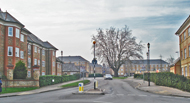
The main entrance to Highlands Village in Highlands Avenue, off World's End Lane.
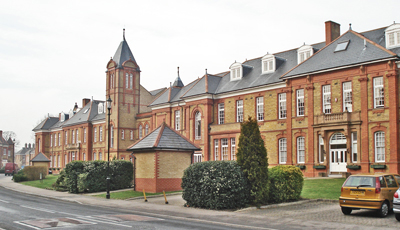
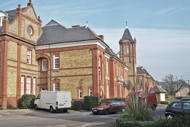
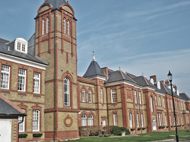
The former administration block on Newsholme Avenue, off Highland Avenue, is now Penrose House. Until 1983 it had a clock tower.
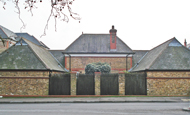
An old gateway flanked by single-storey buildings.

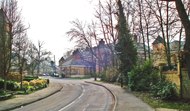
One of the larger pavilions has become Elizabeth Lodge, a care home.
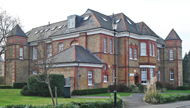

Pavilion No. 14 (left) is now Seacole Lodge and Pavilion No. 16 (right) Jenner Court. The buildings and streets in Highlands Village are mostly named after medical and nursing 'celebrities'.
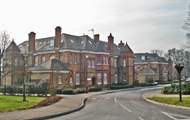
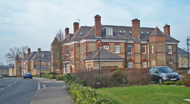
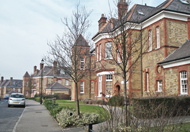
Various pavilions along Pennington Drive.
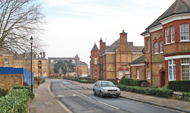
Pavilion 3, seen on the right, was the former Casualty Department.
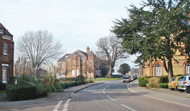

One of the old pavilions (No. 6) still remains boarded up in 2008.
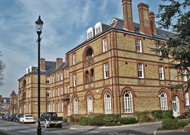
The former Nurses Home is now Pringle House.

Sainsburys supermarket is at the east of the site, to the south of where the former South Lodge Hospital was located.
Encephalitis lethargica
(epidemic encephalitis, von Economo's disease)
(epidemic encephalitis, von Economo's disease)
In
April 1917 the Austrian neurologist Dr Constantin von Economo
(1876-1931) presented his clinical and pathological findings of a new
disaease, first reported in central Europe, to the Vienna Psychiatric
Society. He named it encephalitis lethargica (which means
'inflammation of the brain which makes you tired'). The disease
became also known as 'sleepy sickness' or 'sleeping sickness' although
it was not the sleeping sickness caused by trypanosomes (microscopic
protozoan parasites) transmitted by the tsetse fly.
A worldwide epidemic of this neurological, and often lethal, disease began in 1915, three years before the unusually severe epidemic of influenza ('Spanish flu'). It lasted until about 1930.
The acute phase of encephalitis lethargica was characterised by somnolence and a mask-like facial appearance. Although all ages were affected, young people, especially women, were more susceptible. Some 20-40% of patients of all ages died during the epidemic, and most of those who survived developed sequelae to some degree. The most common was a form of Parkinson's disease, with tremor, rigidity of muscles, and a running or shuffling gait. Oculogyric crises were an important feature; mental changes, especially in children, and respiratory tics (habit cough) were often noted.
The epidemic has never recurred, although isolated cases are still reported. Despite exhaustive research, the aetiology of the disease is still unknown, although it seemed to follow waves of epidemic influenza.
A worldwide epidemic of this neurological, and often lethal, disease began in 1915, three years before the unusually severe epidemic of influenza ('Spanish flu'). It lasted until about 1930.
The acute phase of encephalitis lethargica was characterised by somnolence and a mask-like facial appearance. Although all ages were affected, young people, especially women, were more susceptible. Some 20-40% of patients of all ages died during the epidemic, and most of those who survived developed sequelae to some degree. The most common was a form of Parkinson's disease, with tremor, rigidity of muscles, and a running or shuffling gait. Oculogyric crises were an important feature; mental changes, especially in children, and respiratory tics (habit cough) were often noted.
The epidemic has never recurred, although isolated cases are still reported. Despite exhaustive research, the aetiology of the disease is still unknown, although it seemed to follow waves of epidemic influenza.
References
Dourmashkin RR 1997 What caused the 1918-1930 epidemic of encephalitis lethargica? Journal of the Royal Society of Medicine 90, 515-520.
http://news.bbc.co.uk
www.bbc.co.uk
Dourmashkin RR 1997 What caused the 1918-1930 epidemic of encephalitis lethargica? Journal of the Royal Society of Medicine 90, 515-520.
http://news.bbc.co.uk
www.bbc.co.uk
http://en.wikipedia.org
http://hansard.millbanksystems.com
http://imagepicturedesk.com
http://rcnarchive.rcn.org.uk
www.british-history.ac.uk
www.derelictplaces.co.uk
www.enfield.gov.uk
www.geograph.org.uk
www.workhouses.org.uk
Return to home page